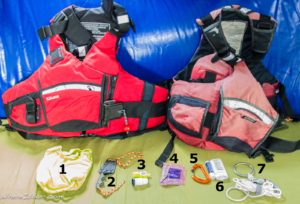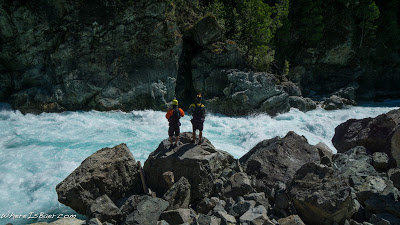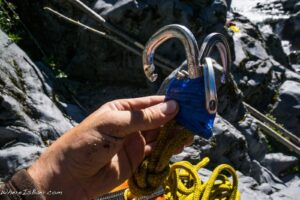Friend, boater, and fellow adventurer Chris Baer guest writes on what he carries with him on the river.
Heading to a new run that might be at the high end of your skill set? That’s an expedition… Time to get prepared! You’re going to want some tools just in case it gets a little wilder out there than you were hoping for.
Medical
When planning my medical kit, I think about the injuries I have received and have been around while kayaking: cuts, bruising, dislocations, broken bones, hypothermia, and drowning. It’s also imperative to understand the pre-existing medical concerns you or your fellow paddlers may be dealing with such as allergies, diabetes, asthma, heart conditions, or seizure disorders. When heading out on an expedition, I always try to clarify if there are any pre-existing issues. If so, make sure the team is ready with extra equipment like inhalers, EpiPens, insulin, nitro tabs, etc.
Below is a quick list of what comes along in my med kit. I like to keep the basics as light and small as possible.
- Medical tape– This is the “band-aid.” Take a small piece, fold it over onto itself, and place on wound. Use more tape to keep it in place. Medical tape can also easily turn into a sling or splint by taping the injured extremity into position of comfort and utilizing drift wood as a splint.
- Anti-inflammatory– This is great for big waterfalls and joint and bone injuries as well as hangovers.
- Antiseptic swabs– Clean that wound!
- Triple antibiotic ointment– Keep the wound clean, and keep the medical tape from sticking to the wound.
- Extra layer– For a massive laceration, you will need a bigger clotting surface so plan on using your shirt or that of the injured person. This is also great if someone gets really cold on the water.
- C.P.R. shield and medical gloves in a freezer bag– Protect from contamination! This goes directly into the front pocket of my PFD.
Rescue
Store your throw bag in an easily reached location. Mine is directly between my legs as I want the ability to throw it from my boat if necessary. I prefer a Spectra or Dyneema line; its strength to weight/size ratio means that I can carry a relatively small throw bag with over 70 feet of line inside. That makes the rope easy to throw and strong enough to handle mechanical advantage systems.
- Knife– If you are using rope, you need a way to cut it. Keep the knife sharp and quickly available.
- Tow tether– An extra long one is necessary if you’re paddling a long boat. The extra line can also be used as prussic in a pinch. Attached to a locking carabiner, this is the line I’m going to attach when the situation is more dynamic (when the carabiner could accidentally be bumped open).
- Non-locking carabiner– Stashed in a PFD pocket, it’s easy and quick to get to when in a pinch; there’s no need to explain to anyone how the locking mechanism works.
- Whistle– Have the ability to make yourself loud. Most fun whitewater is just shy of deafening so if something happens, it’s crucial to let the rest of the crew know quickly and effectively.
- Extra rope– On you! I carry 30 feet of thin Dyneema in a small chest bag. The line is strong, light, and compact; I barely know it’s there. It can be used as an impromptu anchor or as a short range throw bag for creeks.
Limp Home
- Break-down paddle– Buy a nice one that is as close to what you normally use as possible. When you break or lose your paddle, it’s probably not on a easy section of river. The mental comfort of paddling with something that you are used to will be reassuring.
- Head lamp– This one is so frequently overlooked and can really change the outcome of an extra long day.
- Bituthene (Bitch-a-thane)– Roofing tape, this material is basically a tar sticker and can keep a cracked boat afloat for quite some time.
- Camera box– … with webbing sling. The webbing can be removed to repair a back band. Inside the box, I keep a copy of my passport, un-laminated, so that it can be destroyed if necessary (getting abducted by gorillas in Colombia). Also inside the box is a crisp U.S. twenty dollar bill and an equivalent if out of the states. It’s amazing how often a little extra cash has come in handy: bribes, shuttles, gas, a Snickers bar, take out beers.
Things I see a lot of people carrying and why I don’t
- Pre-built prussic– If you’re building a haul system, time is no longer a priority. I double duty my tow tether as my prussic if necessary.
- Lots of carabiners– I’m pretty sure I can tie a Figure 8 or Bowline knot almost as fast as someone can reach into their PFD pocket, root past the Snickers wrapper, retrieve a carabiner, orientate in hand, undo the locking mechanism, clip in, re-lock the carabineer, and check it.
- Water– Over the years, I’ve realized that how much a boat weights can make a huge impact on boat performa
 nce. I drink extra water at the put in and then think like a camel. You can go a lot longer without water than you think. The worst case would result in drinking from the river and dealing with the stomach bugs later. On longer trips, I bring a light weight filter.
nce. I drink extra water at the put in and then think like a camel. You can go a lot longer without water than you think. The worst case would result in drinking from the river and dealing with the stomach bugs later. On longer trips, I bring a light weight filter. - Food– Unless you’re diabetic, toughen up. The average human can go three weeks without food, you can make it to the take out. Gain foraging skills and collect berries and other gather-able nourishment.
I think about this as being the minimum. Longer and more technical sections will call for more equipment. That being said, this stuff is in my boat every day and really doesn’t add that much weight.
Be sure to check out Chris Baer’s blog, whereisbaer.com for more candid accounts of adventure around the globe as well as tips and tricks you won’t want to miss.

